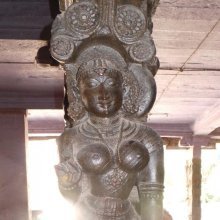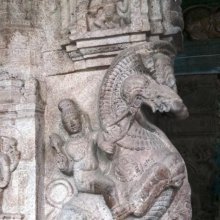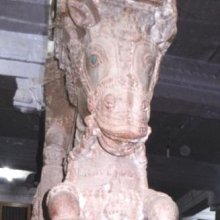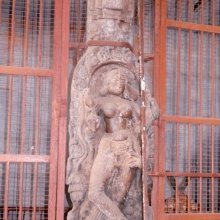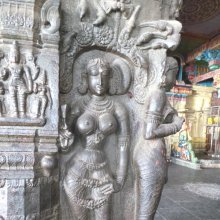Camara, Cāmara, Camará: 38 definitions
Introduction:
Camara means something in Buddhism, Pali, Hinduism, Sanskrit, Jainism, Prakrit, the history of ancient India, Marathi, Hindi, biology. If you want to know the exact meaning, history, etymology or English translation of this term then check out the descriptions on this page. Add your comment or reference to a book if you want to contribute to this summary article.
Camara has 37 English definitions available.
Alternative spellings of this word include Chamara.
Images (photo gallery)
(+10 more images available)
Languages of India and abroad
Sanskrit dictionary
[Deutsch Wörterbuch]
Source: Cologne Digital Sanskrit Dictionaries: Böhtlingk and Roth Grosses Petersburger WörterbuchCamara (चमर):—[Die Uṇādi-Affixe 3, 131.]
1) m. Bos grunniens, ein wegen seines buschigen Schweifes, der als Fliegenwedel zu den Insignien der Könige gehört, hoch in Ehren stehendes Thier, [Amarakoṣa 2, 5, 10.] [Hemacandra’s Abhidhānacintāmaṇi 1294.] [Rājanirghaṇṭa im Śabdakalpadruma] [Mahābhārata 3, 12245.] [Rāmāyaṇa 2, 29, 3. 3, 15, 4.] [Śākuntala 144, v. l.] ein Sumpfthier [Suśruta 1, 204, 10. 205, 2.] Häufig f. camarī als Epicönum (vgl. mahiṣī) [Hemacandra’s Anekārthasaṃgraha 3, 554.] [Medinīkoṣa r. 153.] [Kumārasaṃbhava 1, 13. 49.] [Meghadūta 54.] [Varāhamihira’s Bṛhajjātaka S. 70, 1.] [Bhāgavatapurāṇa 3, 10, 21. 8, 2, 20.] [Śiśupālavadha 4, 60.] keśeṣu camarīṃ hanti Cit. beim Sch. zu [Pāṇini’s acht Bücher 2, 3, 36, Vārttika von Kātyāyana. 5.] —
2) der als Fliegenwedel gebrauchte Schweif des Bos grunniens, m. [Hemacandra’s Abhidhānacintāmaṇi 139.] [Hemacandra’s Anekārthasaṃgraha] [Medinīkoṣa 2, 1861.] [Hemacandra’s Abhidhānacintāmaṇi 61.] n. [Medinīkoṣa] [Mahābhārata 12, 3688.] pavanacamarairvījyamānaḥ [Bhartṛhari 3, 93.] Vgl. cāmara . —
3) eine best. grosse Zahl [Vyutpatti oder Mahāvyutpatti 180.] —
4) m. Nomen proprium eines Daitya [Hemacandra’s Anekārthasaṃgraha] —
5) f. ī ein zusammengesetzter Stiel [Trikāṇḍaśeṣa 2, 4, 5.] [Medinīkoṣa]
--- OR ---
Cāmara (चामर):—(von camara)
1) n. [Siddhāntakaumudī.249,b,2.] [?(nach BHOJA im Śabdakalpadruma] auch m., nach [Bharata] zu [Amarakoṣa] auch cāmarā und cāmarī f.) der Schweif des Bos grunniens, der als Fliegenwedel gebraucht wird und zu den Insignien der Fürsten gehört; häufig werden ihrer zwei erwähnt. [Amarakoṣa 2, 8, 1, 31.] [Trikāṇḍaśeṣa 2, 8, 31.] [Hemacandra’s Abhidhānacintāmaṇi 717.] [Mahābhārata 1, 4943. 2, 1921. 14, 2181.] [Harivaṃśa 4443. 5216.] [Raghuvaṃśa 3, 16.] [Vikramorvaśī 76.] [Meghadūta 36.] [Pañcatantra III, 266.] [Geschichte des Vidūṣaka 335.] [Rgva tch’er rol pa 88.] [Rājataraṅgiṇī 1, 81.] vyajana [Mahābhārata 1, 4941. 6, 670. 3966.] [Harivaṃśa 1290.] [Rāmāyaṇa 3, 9, 7.] Unterschieden von vyajana [Bhāgavatapurāṇa 4, 7, 21.] hāsaiḥ [Harivaṃśa 4649.] grāhiṇī [Bhartṛhari 3, 67.] kirātī cāmaradhāriḥ Cit. beim [Scholiast] zu [Śākuntala 20, 16.] Am Ende eines adj. comp. f. ā [Kumārasaṃbhava 7, 42.] als Schmuck auf dem Kopfe der Pferde [Śākuntala 8.] [Vikramorvaśī 4.] Fliegenwedel überh.: bārhacāmara [Bhāgavatapurāṇa 8, 10, 13.] Nach [Medinīkoṣa] n. und f. ā = daṇḍa Stiel und bālavyajana Fliegenwedel. —
2) adj. vom vorherg.: daṇḍa der Stiel eines Fliegenwedels [Amarakoṣa 3, 4, 25, 187.] —
3) Name eines Metrums (4 Mal ¯ ˘ ¯ ˘ ¯ ˘ ¯ ˘ ¯ ˘ ¯ ˘ ¯ ˘ ¯ ) [Colebrooke II, 161 (X, 12).]
--- OR ---
Camara (चमर):—
1) m. [Rāmāyaṇa 7, 6, 49.] camarī [Spr. 2656.] camarīvāla [Kathāsaritsāgara 59, 42.] —
2) [Kathāsaritsāgara 59, 42.]
--- OR ---
Cāmara (चामर):—
1) bārhacāmara ist adj. und mit vyajana zu verbinden; überhaupt wird cāmara in Verbindung mit vyajana als adj. aufzufassen sein. Auch vyajanacāmare [Bhāgavatapurāṇa 4, 7, 21] wird im Comm. durch cāmaravyajane (also Umstellung) erklärt. Vgl. noch [Rāmāyaṇa Gorresio 2, 12, 9.]
Source: Cologne Digital Sanskrit Dictionaries: Sanskrit-Wörterbuch in kürzerer FassungCamara (चमर):——
1) m. f. ( ī) Bos grunniens. —
2) m. n. der als Fliegenwedel gebrauchte Schweif des Bos grunniens. —
3) *m. oder n. eine best. hohe Zahl (buddh.). —
4) *m. Nomen proprium eines Daitya. —
5) *f. ī ein zusammengesetzter Stiel.
--- OR ---
Cāmara (चामर):——
1) Adj. — a) vom Bos grunniens kommend [Bhāgavatapurāṇa 8,10,13.] — b) zu einem Fliegenwedel gehörig. —
2) (*m. f. ā und ī) und. n. der Schweif des Bos grunniens , der als Fliegenwedel gebraucht wird und zu den Insignien eines Fürsten gehört. Auch als Schmuck auf dem Kopfe von Pferden und Elephanten [Kād. (1872) 109,17.] Am Ende eines adj. Comp. f. ā. —
3) *n. und f. ā Stiel. —
4) n. ein best. Metrum.
Sanskrit, also spelled संस्कृतम् (saṃskṛtam), is an ancient language of India commonly seen as the grandmother of the Indo-European language family (even English!). Closely allied with Prakrit and Pali, Sanskrit is more exhaustive in both grammar and terms and has the most extensive collection of literature in the world, greatly surpassing its sister-languages Greek and Latin.
See also (Relevant definitions)
Starts with (+37): Camara de chumbo, Camara de espinho, Camara vermelho, Camara-kumara, Camara-mada, Camarabala, Camaracam, Camaracanca, Camaracar, Camaracarucihna, Camaracavacani, Camaradhari, Camaradhariga, Camaradharini, Camaragarti, Camaragraha, Camaragrahika, Camaragrahin, Camaragrahini, Camarahasta.
Ends with (+9): Acamara, Ambucamara, Aparacamara, Chatracamara, Dulcamara, Grihacamara, Kancamara, Karnacamara, Krishnacamara, Lantana camara, Manjaricamara, Nicamara, Nikcamara, Pamsucamara, Pancacamara, Pancamara, Pushpacamara, Raktacamara, Sacamara, Shvetacamara.
Full-text (+436): Camarika, Camara vermelho, Camaram, Camara de espinho, Camara de chumbo, Camarapushpa, Vibukosha, Mishamishay, Varicamara, Ambucamara, Ambutala, Camarin, Pulikampa, Camarapuccha, Dirghabala, Mrigamanda, Ghaneri, Camaracanca, Chamar, Srimara.
Relevant text
Search found 58 books and stories containing Camara, Cāmara, Cāmarā, Camāra, Camará; (plurals include: Camaras, Cāmaras, Cāmarās, Camāras, Camarás). You can also click to the full overview containing English textual excerpts. Below are direct links for the most relevant articles:
Garga Samhita (English) (by Danavir Goswami)
Verse 6.1.28 < [Chapter 1 - Jarāsandha’s Defeat]
Verse 2.19.15 < [Chapter 19 - The Rāsa-dance Pastime]
Verses 6.16.6-7 < [Chapter 16 - Seeing Śrī Rādhā’s Form]
Bhakti-rasamrta-sindhu (by Śrīla Rūpa Gosvāmī)
Verse 3.2.40 < [Part 2 - Affection and Service (dāsya-rasa)]
Verse 4.8.22 < [Part 8 - Compatible & Incompatible Mellows (maitrī-vaira-sthiti)]
Verse 1.2.155 < [Part 2 - Devotional Service in Practice (sādhana-bhakti)]
Brihad Bhagavatamrita (commentary) (by Śrī Śrīmad Bhaktivedānta Nārāyana Gosvāmī Mahārāja)
Verse 2.4.72 < [Chapter 4 - Vaikuṇṭha (the spiritual world)]
Verse 1.2.6-7 < [Chapter 2 - Divya (the celestial plane)]
Verse 1.2.98 < [Chapter 2 - Divya (the celestial plane)]
Chaitanya Bhagavata (by Bhumipati Dāsa)
Verse 3.8.110 < [Chapter 8 - Mahāprabhu’s Water Sports in Narendra- sarovara]
Verse 3.4.327 < [Chapter 4 - Descriptions of Śrī Acyutānanda’s Pastimes and the Worship of Śrī Mādhavendra]
Verse 2.22.19 < [Chapter 22 - Delivering Śacīdevī from Offense and Descriptions of Nityānanda’s Qualities]
The backdrop of the Srikanthacarita and the Mankhakosa (by Dhrubajit Sarma)
Part 5c - Alaṃkāra (3): Rūpaka or metaphor < [Chapter III - Literary Assessment Of The Śrīkaṇṭhacarita]
Related products
